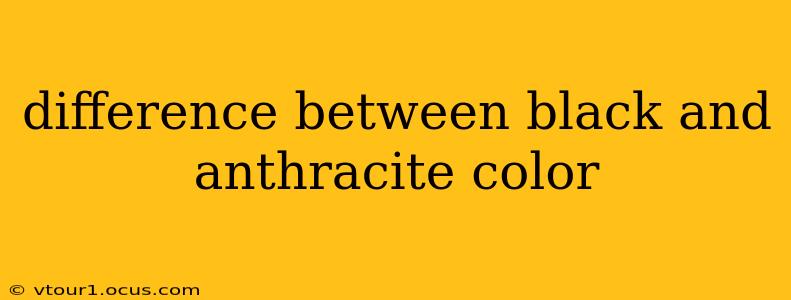Decoding the Darkness: Unveiling the Difference Between Black and Anthracite
Black and anthracite are both dark colors, often mistaken for one another. However, a subtle yet significant difference exists, impacting their use in everything from fashion and interior design to automotive finishes. Understanding this nuance can significantly improve your design choices and color selection.
What is Black?
Black, in its purest form, is the absence of all light. It's a powerful, versatile color associated with sophistication, formality, and mystery. In practice, however, what we perceive as "black" often contains undertones or hints of other colors, especially when dealing with pigments or dyes.
What is Anthracite?
Anthracite is a very dark gray, often described as a "charcoal gray" or a "dark gray with blue undertones." It's named after anthracite coal, a type of coal known for its high carbon content and dark, almost black appearance. Unlike true black, anthracite possesses a slight luminosity; it reflects a tiny amount of light, giving it a slightly softer, less stark appearance compared to pure black.
How Can You Tell the Difference?
The key difference lies in the subtle hints of color and the level of light reflection.
-
Light Reflection: Anthracite reflects a minute amount of light, making it appear less harsh and more nuanced than pure black. Black, on the other hand, absorbs nearly all light. This difference is most noticeable when comparing the two colors side-by-side under consistent lighting conditions.
-
Undertones: Anthracite often contains cool undertones, typically leaning towards blue or gray. Black, while sometimes containing subtle undertones depending on the pigment, generally lacks the distinct cool undertones of anthracite.
-
Visual Impact: Anthracite feels more muted and less dramatic than black. Black commands attention and often appears bolder, while anthracite provides a softer, more subdued elegance.
Where is Each Color Best Used?
The choice between black and anthracite depends largely on the desired aesthetic:
-
Black: Ideal for creating dramatic effects, adding depth, and making a strong statement. Common uses include formal wear, high-contrast design, and automotive finishes where a bold, powerful look is desired.
-
Anthracite: Better suited for situations where a softer, more sophisticated look is preferred. This color is commonly used in interior design, where it can provide a neutral yet stylish backdrop without being overwhelming. It's also popular in automotive finishes offering a modern and slightly less harsh alternative to black.
Frequently Asked Questions
Q: Is anthracite a shade of gray or black?
A: Anthracite is technically a very dark shade of gray, often described as a dark gray with blue undertones. While it appears almost black, the subtle differences in light reflection and undertones distinguish it from true black.
Q: Which color is more versatile, black or anthracite?
A: Black's versatility is widely acknowledged due to its ability to pair with virtually any other color. Anthracite offers a sophisticated versatility, complementing neutral and cool-toned palettes especially well. The "more versatile" color truly depends on the context and personal preference.
Q: Can I use black and anthracite together?
A: Absolutely! Using black and anthracite together can create stunning visual effects, playing with the contrast between a deep, commanding black and a softer, more subtle anthracite. This combination often adds depth and complexity to a design.
Q: What are some examples of anthracite in everyday life?
A: Anthracite is found in many areas, including: some car paints, certain shades of clothing (particularly in men's fashion), and in interior design (walls, furniture, flooring). The color often appears in more muted and less intense applications compared to black.
By understanding the subtle but important differences between black and anthracite, you can make more informed decisions when choosing colors for your projects, ensuring that the final result perfectly reflects your vision and aesthetic goals.
